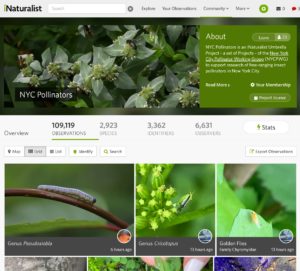Engage with Pollinators

One of the world’s most popular nature apps, iNaturalist helps you identify the plants and animals around you. Get connected with a community of over a million scientists and naturalists who can help you learn more about nature. You can take action to address global pollinator decline by helping researchers track pollinator activity simply by observing pollinators in your area and adding it to iNaturalist. What’s more, by recording and sharing your observations, you’ll create research quality data for scientists working to better understand and protect nature.
Join the NYCPWG iNaturalist Project at inaturalist.org/projects/nyc-pollinators. NYC Pollinators is an iNaturalist Umbrella Project – a set of Projects – of the New York City Pollinator Working Group (NYCPWG) to support research of free-ranging insect pollinators in New York City.
Center for Biological Diversity
The Center for Biological Diversity knows that the depth of change that needs to happen is beyond the scope of any one organization. We invite you to take action in your community, build political power by connecting with others, and develop your skills as an agent of change.
Create Pollinator Habitat
One of the best things you can do to help NYC pollinators is to create healthy habitat and plant natives anywhere you can!
- Habitat opportunities abound on every landscape – from window boxes to acres of farms to corporate campuses to tree beds and roadside corridors – every site can be habitat.
- Utilize plants native to your area (or at the least, non-invasive for your area).
- Utilize the Pollinator Partnership Ecoregional Planting Guides and the Garden Recipe Cards to create or enhance your pollinator garden. Decide among the plant material options – seeds, plugs, plants or a combination.
- Know your soil type and select appropriate plant material.
- Plant in clusters to create a “target’ for pollinators to find.
- Plant for continuous bloom throughout the growing season from spring to fall.
- Select a site that is removed from wind, has at least partial sun, and can provide water.
- Allow material from dead branches and logs remain as nesting sites; reduce mulch to allow patches of bare ground for ground-nesting bees to utilize; consider installing wood nesting blocks for wood-nesting natives.
Learn more about NYCPWG Policies
Read the most recent pollinator policy statements and research HERE